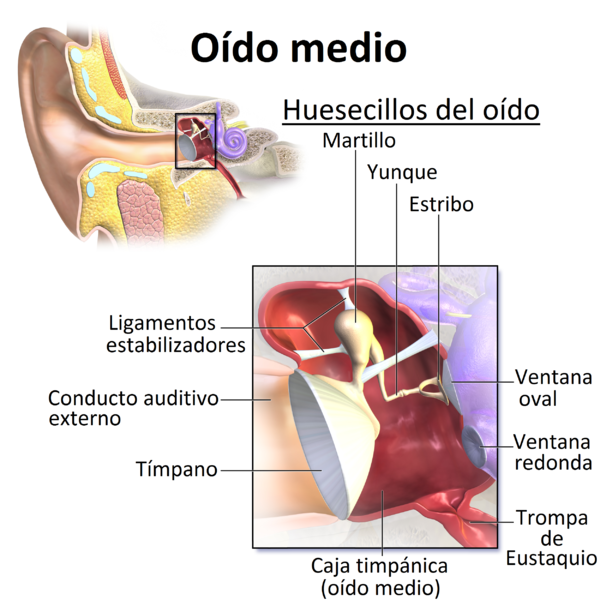- The outer ear made up of the pinna (or ear) and the auditory canal. The ear directs sounds into the external auditory canal that carries them to the eardrum.
The eardrum separates the outer ear from the middle ear, and is made up of a membrane that vibrates when sound waves arrive.
The ear canal has glands that produce wax with a protective function.

- The middle ear begins with the eardrum and ends in membranes called the oval window and the round window. When the eardrum vibrates, the vibration is transmitted to a chain of ossicles called the hammer, anvil and stapes, which communicates with the oval window belonging to the inner ear. Thus, the vibration is transmitted to the inner ear.
-
The Eustachian tube is a tube connected to the pharynx, which allows the pressures on both sides of the eardrum to equalize. It is also responsible for some curious phenomena in our ears, such as that we do not recognize our voice when we listen to a recording, since we hear it from the inside and not from the ears. It also unclogs our ears when they become clogged by the pressure difference that occurs when going up a port by car, when diving or traveling by plane.

By BruceBlaus [CC BY 3.0], via Wikimedia Commons
- The inner ear is made up of a membranous labyrinth filled with a fluid called endolymph. The labyrinth is made up of:
- The snail or cochlea that detects sounds, transforming the vibrations produced by sound into nerve impulses, and sends them to the encephalon through the auditory nerve.
 The cochlea is a bony structure shaped like a snail. It contains in its interior hair cells, which are part of the organ of Corti, capable of detecting sound vibrations.
The cochlea is a bony structure shaped like a snail. It contains in its interior hair cells, which are part of the organ of Corti, capable of detecting sound vibrations.
- The vestibule (or vestibular apparatus) that controls body position and balance. It is made up:
- Three semicircular canals arranged perpendicular to each other, oriented in the three directions of space.
- Two vesicles (utricle and saccule).

By BruceBlausDe la traducción Ortisa [CC BY-SA 4.0], via Wikimedia Commons
Animación: Anatomy of the ear.


